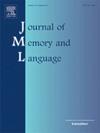词汇语气的不同和特殊:证据来自于一个快速重复的生产任务
IF 3
1区 心理学
Q1 LINGUISTICS
引用次数: 0
摘要
启动实验和语音错误研究发现语音编码存在跨语言差异。值得注意的是,英语和普通话的第一个可选择单位(近音单位)是不同的,前者首先选择辅音(c)和元音(v)这样的片段单位,而后者选择整个音节。此外,普通话是有声调的,这意味着同一个音节是一个不同的词,取决于它说话的音调。然而,在语音产生的语音编码过程中,声调是如何表征和加工的,是与元音或元音相连,还是独立加工,目前尚不清楚。在三个实验中,我们通过测量说话者产生带有音调的CV音节序列的速度来调查这些问题。与英语不同,生产速度与计划重用没有直接联系(见Sevald &;戴尔,1994)。相反,当每个CV仅用一种音调生成时(即,ba2 di1 da1 bi2和ba1 ba1 ba1 ba1 ba1),与使用多个音调生成特定CV时(即,ba1 ba2 ba1 ba2较慢的语音速率)相比,语音速率明显更快。我们建议说普通话的人将CV表示为音节“块”,将声调(CV结构框架的一部分)与CV(而不是元音)整合在一起,并且由于需要将不同的音调重新分配到相同的CV块中,因此用多个音调在一个序列中生成相同的CV是困难的。本文章由计算机程序翻译,如有差异,请以英文原文为准。
Lexical tone is different and special: evidence from a speeded repeated production task
Priming experiments and speech error studies have found cross-linguistic differences in phonological encoding. Notably, the first selectable unit (the proximate unit) differs between English and Mandarin Chinese, with the former selecting segmental units like consonants (Cs) and vowels (Vs) first, while the latter selects syllables as a whole. Further, Mandarin Chinese is tonal, meaning the same syllable is a different word depending on the tone it is spoken with. However, it remains unclear how tone is represented and processed during phonological encoding in speech production – attached to the vowel or CV, or processed independently. Across three experiments, we investigated these questions by measuring how quickly speakers produced sequences of tone-bearing CV syllables. Unlike English, speed of production was not directly linked to plan reuse (see Sevald & Dell, 1994). Instead, speech rate was robustly faster when each CV was produced with only one tone (i.e., about equal speech rate for ba2 di1 da1 bi2 and ba1 ba1 ba1 ba1), compared to when a particular CV was produced with more than one tone (i.e., slower speech rate for ba1 ba2 ba1 ba2). We suggest that Mandarin speakers represent CVs as syllable “chunks,” integrating tone—a part of the structural frame with the CV (rather than a vowel), and producing the same CV with more than one tone in a sequence is difficult as a result of needing to reassign different tones to the same CV chunk.
求助全文
通过发布文献求助,成功后即可免费获取论文全文。
去求助
来源期刊
CiteScore
8.70
自引率
14.00%
发文量
49
审稿时长
12.7 weeks
期刊介绍:
Articles in the Journal of Memory and Language contribute to the formulation of scientific issues and theories in the areas of memory, language comprehension and production, and cognitive processes. Special emphasis is given to research articles that provide new theoretical insights based on a carefully laid empirical foundation. The journal generally favors articles that provide multiple experiments. In addition, significant theoretical papers without new experimental findings may be published.
The Journal of Memory and Language is a valuable tool for cognitive scientists, including psychologists, linguists, and others interested in memory and learning, language, reading, and speech.
Research Areas include:
• Topics that illuminate aspects of memory or language processing
• Linguistics
• Neuropsychology.

 求助内容:
求助内容: 应助结果提醒方式:
应助结果提醒方式:


